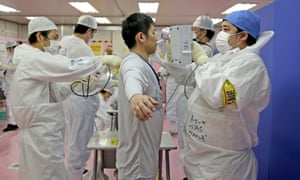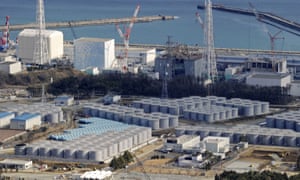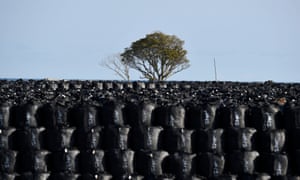
In the chaotic two years after its name became forever associated with nuclear disaster, the Fukushima Daiichi power plant “resembled a field hospital”, according to the man who is now in charge of the most daunting task the nuclear industry has ever faced: removing hundreds of tons of melted fuel from the plant’s stricken reactors.
“Now it really does feel like the situation is settling down and we can look ahead,” said Naohiro Masuda, head of decommissioning at the plant’s operator, Tokyo Electric Power Company (Tepco).
Five years after a magnitude nine earthquake triggered a giant tsunami that killed almost 19,000 people along the north-east coast of Japan and caused a triple meltdown at Fukushima, the plant has been transformed from the scene of a major disaster into a sprawling building site.
Masuda can point to lower radiation levels in and around the plant, better conditions for its 1,200 Tepco staff and 6,000 other workers – including the recent provision of hot meals and a rest area – and progress in containing huge quantities of radioactive groundwater.
In late 2014, the utility overcame arguably the most dangerous challenge since the meltdown, with the removal of hundreds of spent fuel rods from a storage pool inside a damaged reactor building.
But work on removing the melted fuel – something no nuclear operator has ever attempted – has barely begun.
All that Tepco knows for certain – although it was slow to admit it – is that fuel in three reactors melted down after the tsunami knocked out the plant’s cooling system on 11 March 2011.

Of greatest concern, though, is reactor 1, where the fuel may have burned through the pressure vessel, fallen to the bottom of the containment vessel and into the concrete pedestal below – perhaps even outside it – according to a report by the International Research Institute for Nuclear Decommissioning. Reactors 2 and 3 are thought to have suffered partial meltdowns.
Masuda and Tepco engineers who spoke to the Guardian conceded that they still didn’t know where the fuel is located. “To be honest, we don’t know exactly where the fuel is and have to carry out more studies,” Masuda said at a recent briefing. “But we do know that the fuel is in a solid state of cold shutdown.
“No one has ever done what we’re doing, but 30 to 40 years is a target that we can work towards. There are so many people involved that it would be wrong to alter that deadline on a whim. We’ve established a goal and need to show ingenuity to reach it, not take the easy way out.”
The technology needed to send robots deep into the reactors’ bowels – where radiation levels are dangerously high – has yet to be developed. Two robots specially tailored to negotiate debris inside damaged tunnels and pipes stalledlast year when they closed in on the reactors’ highly radioactive innards.
Yet Tepco is persisting with the government’s roadmap for the Fukushimacleanup, which envisions fuel removal to begin in 2021 and end between 30 and 40 years later, at an estimated cost of almost $20bn (£14bn).
But Shaun Burnie, senior nuclear specialist at Greenpeace Germany, said the decommissioning schedule was an attempt to convince the public that Japan was recovering from a major nuclear disaster.
“The idea that fuel debris removal will begin in 2021 is not realistic – it’s just not going to happen,” he said. “The roadmap is based on political considerations, not technical ones.
“This applies to the government’s and industry’s approach to the whole Fukushima crisis – to give the impression that things are retuning to normal and to weaken public opposition to the restart of nuclear reactors.
“No one really knows how long it will take, but it will be decades and decades and decades.”
As the deadline for the start of fuel removal edges closer, even industry regulators are beginning to question the methods set out in the current decommissioning plan.

Last month, Toyoshi Fuketa, a nuclear regulatory authority commissioner, suggested removing all of the melted fuel could take much longer than four decades. “I wonder if it is desirable for work to extract fuel debris to still be going on 70 or 80 years from now,” Fuketa told reporters. “There are a number of other options, including removing as much fuel as possible and solidifying the rest.”
Fukushima Daiichi’s stability is wholly dependent on water constantly being directed into the reactor basements to prevent the fuel inside from heating up. While the method has proved effective, it has led to a buildup of enormous quantities of contaminated water – a mixture of the coolant and groundwater that becomes radioactive when it flows from hills behind the plant into the reactor buildings.
The contaminated water is then pumped out and stored in tanks that cover large areas of the Fukushima Daiichi site. Tepco is able to remove 62 radionuclides from contaminated water – but not tritium – and has so far been unable to get permission from local fishermen to release the treated water into the Pacific Ocean.
While pumping out groundwater upstream and redirecting it into the sea has reduced the amount flowing into the reactor basements from 400 tonnes to 150 tonnes a day, the technology that was supposed to deliver a coup de grace to Tepco’s perennial water problem has encountered problems.
The utility’s plans to activate a 32bn yen (£198m) impermeable frozen wall, which was completed earlier this year, have been frustrated by delays and questions about its effectiveness. It hopes to start filling the underground wall’s maze of pipes with water later this year.
The site is nearing its current water storage capacity of 850,000 tonnes, and there are plans to add to the existing 1,000 tanks, bringing the amount of contaminated water at the plant close to one million tonnes.
Tepco expects to have collected and treated all contaminated water pooled around the reactors by 2020, and will need to continue processing only coolant water for the reactors, according to Sadanobu Kanno, a general manager in the firm’s nuclear power and plant siting division.
The slow progress at Fukushima is mirrored in the painstaking effort to make nearby towns and villages, abandoned five years ago, fit for human habitation.

The disaster forced 160,000 people to flee their homes, 100,000 of whom are stilldisplaced. About 10,000 children whose families fled after the nuclear disaster have yet to return to Fukushima prefecture, amid parental concern over the possible health effects of long-term exposure to relatively low doses of radiation.
Their former hometowns have since been turned into temporary dumping grounds for more than 10m black bags containing soil and other low level radioactive waste cleared from areas around homes, schools and other public buildings.
Here, too, progress is slow, with local authorities reporting that more than 40 communities have yet to be decontaminated. The unprecedented cleanup, involving 26,000 workers, aims to reduce outdoor radiation exposure to one millisievert a year – a target Japan’s environment minister recently criticised asunrealistically low.
But in a blow to the government’s push to lift more evacuation orders in Fukushima communities over the next 12 months, a poll published on the eve of the fifth anniversary of the disaster showed that two out of three nuclear evacuees had given up hope of ever returning to their homes.
“It is wrong for the central government to say return home and to lift evacuation orders, even though its own declaration of an emergency situation for the nuclear accident is still in place,” said Miyako Kumamoto, a 73-year-old evacuee, at a rally in Tokyo last week.
[Source:- Gurdian]
